History
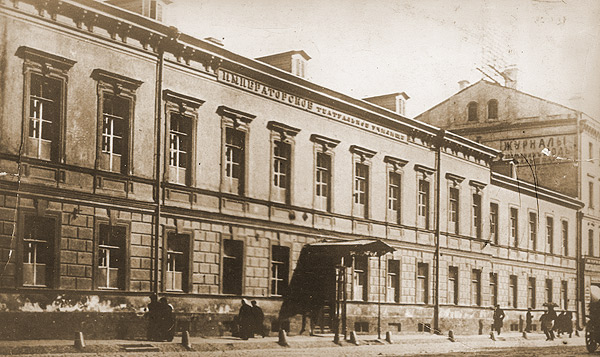 |
| The Imperial Theatre School (historic photo from the beginning of the 20th century) |
The Mikhail Shchepkin Higher Theatre School (Institute) of the State Academic Maly Theatre of Russia is the oldest theatre school in Moscow.
Its roots go back to the Imperial Theatre School of Moscow established by Emperor Alexander I on 28 December 1809, who decreed to set up the first Moscow’s theatre school for the «improvement of Russian performances and ballets, the filling in and, if possible, the establishment of orchestras and the replacement of foreign artists by theatre students.»
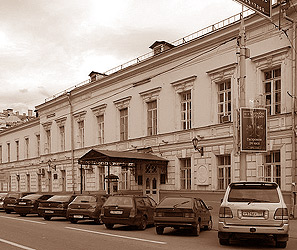 |
| The Mikhail Shchepkin Higher Theatre School (Institute) on Neglinnaya street |
The first enrolment of the School was composed of 30 pupils, 15 girls and 15 boys aged 7-10 years. The majority of them were the children of those who served at the Theatre administration department. The first two divisions were considered preparatory, whilst the third and fourth were destined for the most gifted students. The latter «were entrusted solely to the choreographer, musician or teacher of recitation», i.e. perfected themselves in ballet, music or dramatic art. During the training a lot of attention was paid to ballet classes. The school provided its students with a wide range of educational and career possibilities - drama artist, ballet dancer, musician, props maker and stage-hand. Among the core disciplines were vocal training, dance, sword play, playing various musical instruments. School graduates got placements with leading theatres of Moscow and St. Petersburg and for ten years had no right to retire from service.
From the first days of its existence, the School was located in one of the buildings on Okhotny Ryad, near the Petrovsky Theatre, in possession of the Directorate of Imperial Theatres in Moscow. During the Patriotic War of 1812, the School was evacuated to Vladimir, from there it moved to Kostroma, then - to Plyos. The chronicle testifies that during these difficult times the School, despite constant relocations, never discontinued its activity. In Plyos the School remained until the end of the war, and then moved back to Kostroma, where the students performed in the governor's house.
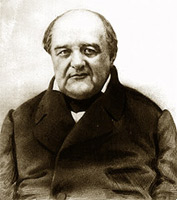 |
| Mikhail Shchepkin |
Upon its return to Moscow in 1814, it emerged that the building of the School had burned down. Since then for more than half a century, the School didn’t have a permanent residence. At first, the S. S. Apraksin's House in Znamenka was temporarily used at rent, and since 1818 the School occupied Lieutenant Colonel Esipov’s House on modern Volkhonka street. By the beginning of the 1820s the School’s staff and the number of pupils had significantly increased (over 100 people). As a result, in 1823, it had to move to a bigger residence - General A.D. Balashov’s house on Povarskaya Street. The ballet classes were given higher priority as before. V.I. Zhivokini, one of the graduates of 1825 and an artist of the Maly Theatre to come, bitterly confessed that in the drama classes students were taught «something and somehow». In 1829 a new School regulation was established, according to which it was held that special attention would be paid to the preparation of relevant drama artists. By this time the School had changed its address again and was now housed in Count F.A. Tolstoy’s residence on Bolshaya Dmitrovka (now the building where the Russian State Arts Library is located).
The focus of «government authorities» on the dramatic art coincided with Mikhail Shchepkin’s first years of work at the Moscow Theatre School. Shchepkin began his «teaching» career in 1832 as a «teacher of recitation», as he was registered in the documents back then. «Having assumed this kind of responsibilities and being used to perform all my duties scrupulously,» the actor recalled, «I rarely missed classes at school... Soon I got to know all the children... and we lived together, learned a little, but rather efficiently.»
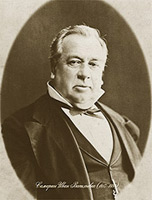 |
| Ivan Samarin |
Shchepkin taught students for over thirty years at the School. The 40-50-ies of the 19 century of the School’s life and activity are inseparably linked with the name of this great actor and an outstanding teacher. His contemporaries called him a «living example», because Shchepkin was extraordinarily effective at leading and influencing the students, and considered one of his main tasks, apart from professional training, to give them a quality moral education. «He contributed to a rational development of many talented artists» wrote Solovyov (actor and director at the Maly Theatre at that time) – he not only showed them a true path to possible perfection, but he also gave them guidance along the path. It was a great time when practical lessons on dramatic art laid foundation of techniques and skills in realist acting. Among Shchepkin’s students were the great masters of the Russian stage: Samarin, Shumsky, Fedotova.
One of the most important events in the history of the School was the acquisition of permanent residence. In 1856 the management of the Imperial theatres acquired a building on Neglinnaya Street, the former cantonist institution. In 1863 it was rebuilt by architect Polzikov according to the project designed by Alberto Cavos, the chief architect of the Imperial theatres. Today this building is a valuable historical and architectural monument of the XIX century, as evidenced by a protective board on its facade, established in December 1992.
Students not only attended the courses at the School, but also lived in its dormitories during term time. Everyday life was rather simple. Every dormitory accommodated up to 12 students, the nannies and the schoolmasters were placed behind the partition wall. The day started with the bell at 8 o'clock in the morning, after everyone gathered for a collective prayer, the breakfast started at 9 a.m. After the breakfast up till 12 o'clock there was a lesson in the ballet class, from 12 to 4 o'clock in the afternoon there were so-called «scientific classes» with a short break for lunch. At 5 o'clock in the evening all the students that were engaged in performances, were taken to the theatre by the carriage. From the testimonies of contemporaries the students were ridiculously dressed: they were wearing pale green trousers and jackets of rotten cloth, somehow patched up.
The students were also badly fed: in the morning they were given a glass of some hot drink and a crust of bread, as a second breakfast they were given a piece of black bread; lunch and dinner consisted of two dishes. The students were not permitted to go home often, only for major holidays…
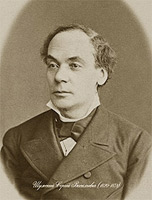 |
| Sergey Shumskiy |
Despite Shchepkin’s obvious success in preparation of dramatic talents for the stage, he desperately wanted to establish drama acting classes. The self-taught actor, who reached the peak of his glory thanks to natural talent and hard work, he understood well the significance of theatre education for the future of the Russian theatre.
In the beginning of the 1860s Shchepkin's work was continued by one of his students, Maly Theatre’s actor Ivan Samarin. Glikeriya Fedotova, who studied both under Shchepkin and Samarin recalled: «Those lessons that actually did not last long laid the groundwork for my entire life, illuminated all the basic techniques that I use up until now when preparing for a role.» Unfortunately even Samarin failed to change management’s attitude towards preparation of dramatic actors. Moreover, a few years later he was fired, and teaching dramatic art gradually came to nothing.
Great nineteenth-century Russian playwright Alexander Ostrovsky made an important contribution to the development of the School. He was the chairman of the school's examination board for many years. He predicted a great future for one of his students, a graduate of 1871, Maria Ermolova, who became a prominent tragic artist and was the first actress of the drama theatre to receive the title of People's Artist of the Republic in 1920.
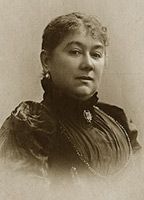 |
| Glikeriya Fedotova |
Supporting the ideas of Shchepkin and Samarin, Ostrovsky was extremely concerned about the development of the Russian Drama Theatre. He was convinced of the importance of the School – «without the school there are no artists, and without artists there is no theatre» and therefore developed an educational program for the drama class. Ostrovsky was no less concerned about the lack of the Imperial theatres’ management’s interest in providing comprehensive vocational training for dramatic actors, and hence in 1882 he presented a «Memorandum on theatre schools» to the Commission to review the regulations on all parts of the theatre department. «Eradication of preparatory drama classes at the imperial theatres had a disastrous impact on the performing arts and the craft of acting that are yet to recover even given all most energetic efforts», the memorandum said. The Commission concluded to keep Ostrovsky’s report and the suggested detailed curriculum in mind when drafting the Regulations for the Imperial Theatre School. However, during the playwright's lifetime, the memorandum was never properly considered. However, in 1885-1886, acting classes functioned under the direction of Glikeriya Fedotova and Osip Pravdin. In 1888 it was officially announced that a special drama department will be established at the school, guided by principles and requirements suggested by Alexander Ostrovsky.
The 1890s was a qualitatively new stage in School’s life. The acting classes finally became equal in rights with the dancing classes. «I remember how skeptical and mistrustful, and even hostile were the actors towards the newly established acting classes at the Maly Theatre, - wrote Yuri Yuryev, People's Artist of the USSR to-be,- Is it possible to create a talent? Every talent is genuinely natural, authentic! – they used to say, as if the purpose of the school was to produce talents ...
There was a certain unfriendly and ironic attitude towards us, the students of the acting classes, among the others. We could feel that in the air. So, your courses consist only of the Mochalovs and the Karatygins, don’t you think too much of yourself anyways? I often heard this ironic question even from the eminent actors of the Maly Theatre.»
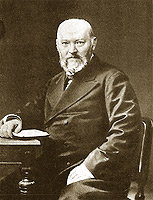 |
| Alexander Ostrovsky |
In the 1890s and the early 1900s, the School’s activity was largely determined by an outstanding actor and director of the Maly Theatre Alexander Lensky, who was appointed as a teacher of «practice of dramatic arts» in November 1888. A talented theatre teacher, he became an embodiment of an ideal actor, a role model, a central figure on the stage Olympus, who paved the way for Stanislavski.
Lensky regarded artist’s formation and development as the the main incentives for the prosperity of the theatre. He took Shchepkin’s methods and Ostrovsky’s theatre programme as a basis for the development of a new four-year actor-training programme. Lensky’s main concept was training an actor as a versatile personality. He claimed: «Drama School, like any other higher and special educational institution is supposed to give its pupils such a storage of knowledge on specialized, comprehensive and subsidiary subjects that will be useful in every situation they encounter In their practice.» As opposed to the widely circulated theories of spontaneous, «instinctive» and «inspired» acting, Lensky demanded from the actor a serious culture and skills to work. At the Maly Theatre a special box was allocated for the students so that they could watch all the performances that were later subject to general discussion and analysis. Back then a number of major experts in the fields of history of literature and theatre have been invited to give lectures at the School – professors at Moscow University, Matvey Rozanov, Alexey Veselovskiy, Nikolay Storozhenko.
Lensky paid special attention to acting practice and engaged his students in Maly Theatre’s productions. Leonid Leonidov, a famous actor, who in the Moscow Art Theatre, recalled: «Those minor roles gave me a lot, I got a practical idea of what a theatre and a performance are…I managed to get over shyness which is so typical for the newcomers, learnt to wear a costume, to walk on stage». Lensky considered necessary to introduce students to all theatre professions. For example, everyone had to be able to prompt and to work as a stage manager.
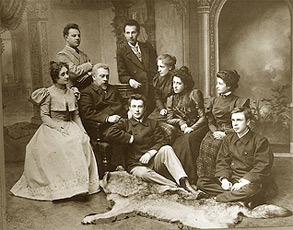 |
| Alexander Lensky with his students. Alexander Ostuzhev is sitting in the middle. |
In the 1890s the theatre press distinguished the students of Lensky and Pravdin as experienced artists who could easily perform on the stage. Lensky raised more than one generation of prominent actors, who became grand masters of the performing arts – Mikhail Lenin, Alexander Ostuzhev, Yuri Yuryev, Vera Pashennaya, Varvara Massalitinova, Evdokiya Turchaninova, Varvara Ryzhova. In the 1890s, two thirds of the Maly Theatre’s company consisted of the School’s graduates. «The best productions on the stage of the Maly Theatre came out from the Moscow Theatre School», - stated the magazine «Theatre» in 1909.
In 1899-1902 in order to expand the premises it was decided to rebuild the outhouses of the school. The old buildings along the Neglinnaya and Sofiyka streets underwent some alterations, as a result of which an enclosed inner courtyard was formed, intended for strolls. On the fourth floor of the outhouse there was a chapel of Mary Magdalene, and Alexey Bakhrushin, a founder of Theatre Museum, now bearing his name was appointed warden of the church. The ceremony of consecration of the chapel took place on March 29, 1903.
The difficult period between two revolutions had a huge impact on School’s life. It experienced a remarkable decline - in 1910 admission to acting classes was temporarily discontinued. Only ballet classes were preserved. During World War I the School provided humanitarian help: a hospital for soldiers was opened within its premises. «In 1917-1918, during the revolution, a machine gun stood under the windows, and around the school, lit by the glow of the fire of the Bolshoi Theatre, there was a roar of guns ... there was a gunfight ...», recalled the School inspector of those years. The time of the Imperial Theatre School was over. The Soviet period began.
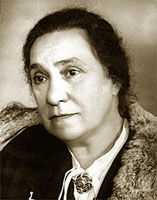 |
| Vera Pashennaya |
On April 24, 1918, the Theatre School was unexpectedly closed by the decision of the special committee, but soon its activity was resumed thanks to Anatoly Lunacharsky. However, initially it was decided to preserve only the ballet classes at the School that were transferred under the jurisdiction of the Bolshoi Theatre's director Leonid Sobinov, and later on to Vasiliy Tikhomirov.
The idea for reviving the acting classes came to the most influential artists of that time, great masters of the Maly Theatre’s stage - Alexander Yuzhin, Sergey Aydarov, Vera Pashennaya, Nadezhda Smirnova. In the autumn of 1918 the drama classes were reopened, the school came under the patronage of the Maly Theatre, soon turning into a theatrical college. New provision and the programme were approved. Aydarov was appointed director of the Schhol, and Pashennaya and Smirnova led the first course. The drama courses were housed in the same old building on Neglinnaya street. In 1919 the drama classes were separated from the ballet classes that achieved independence as the first State Ballet Academy.
In the 1920s the greatest theatrical personalities such as Sergey Aydarov, Nikolay Kostromskoy, Ivan Platon, Nadezhda Smirnova, Sergey Golovin conducted classes in acting. Leading experts in the fields of art and literature delivered lectures to students. Among the graduates of that time were the great masters of the stage – Vsevolod Aksyonov, Fyodor Kaverin (founder of Kaverin’s studio), Nikolay Annenkov, Evegeniy Velikhov, Varvara Obukhova, Sofya Fadeeva.
In 1922-1932 the School was called «Theatre Workshops at the State Academic Maly Theatre», then it became the Theatre Training School. The training school, whose duty was to train actors not only for the Maly Theatre, but for the whole country, was named after Mikhail Shchepkin. Finally, in 1935 the School was officially named - The Mikhail Shchepkin Theatre School.
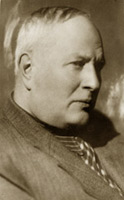 |
| Konstantin Zubov |
In the 1930s and 1940s the teaching staff at the School was further extended and thus became more consolidated. Shchepkin's traditions were enriched with modern achievements of the Russian theatre. Stanislavski’s modern system of actor training, preparation, and rehearsal technique became part of the teaching practice.
Thanks to the efforts and the initiative of Vera Pashennaya and the School’s director Shashkova in 1943, the school received the status of a higher educational institution. Four departments have been established that still operate nowadays: Department of Acting, Department of Stage Elocution, Department of Art Studies, and Department of Marxism-Leninism (Department of Philosophy and Culture Studies today). Almost half a century later, another one was added to the four departments - Department of Gestural Expression that was set up in 1985. Since gaining the status of a higher education institution, the School has been headed in different years by: Shashkova, Severin, Novohizhin, Ostalsky. Since 1947, the year of the first graduating class, the students of the School get higher education in arts and humanities and a diploma in theatre and film acting.
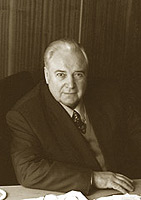 |
| Nikolay Afonin |
In 1943 Department of Stage Elocution was founded, headed by Olimpiada Golovina, and soon a special scenic speech department was established (at the initiative and headed by Mikhail Tsaryov). That was a big step for the School in finding its identity. Ever since the School has been the custodian of emphatic Russia speech producing a great number of famous reciters.
Vera Pashennaya, an outstanding actress, director, teacher, People's Artist of the USSR, played a great role in School’s history. She belonged to the generation of theatre figures, who had a difficult mission: to contribute to the establishment of the Russian theatre and the national acting school in the post-revolutionary era.
Carefully preserving the traditions of the Maly Theatre’s school and remaining faithful to the legacy of Lensky, Pashennaya was the leading teacher of the School for more than forty years, and largely determined the artistic policy of the institution. Among her students are People's Artist of the USSR Yuri Solomin, People's Artist of the USSR and Belarus Alexandra Klimova, People's Artist of Russia Konstanciya Roek. Today Pashennaya's students are the leading teachers at the school, the artistic directors of the courses: Yuri Solomin, Olga Solomina, Dmitriy Koznov.
Viktor Korshunov and Vladimir Monakhov started teaching in the 1950s, in 1960s - Yuri Solomin. In the 1960s and 1970s Nikolay Afonin, Vladimir Seleznev, Mariya Velikhova, Rimma Soltnseva, Nataliya Petrova became teachers at the school.
A significant period in the history of the School, almost half a century, is associated with the name of the People's Artist of the USSR Nikolay Annenkov. He graduated in 1924 and in 1947 he returned to his Alma mater as a teacher and soon became the head of department of mastery of acting. In 1991 he was appointed artistic director of the School and remained in that position there until the end of his life.
The school is famous for its approaches to training ethnic performers and producing creative theatre workers for the small national republics of Russia. Pashennaya was the one who proposed to establish the first national studio for Yakutia (1950-1955). Over 50 ethnic studios have graduated from the school since the Yakutia Studio was first assembled. Among the graduates (more than a thousand by now) are popular honored actors, major directors, famous playwrights, eminent artists, who work across the former Soviet Union.
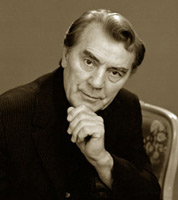 |
| Viktor Korshunov |
The Mikhail Shchepkin Higher Theatre School produced a galaxy of brilliant actors and actresses of the second half of the 20th century, giving the world such names as Pavel Luspekayev, Nikita Podgorniy, Oleg Dal, Yuri Solomin, Svetlana Nemolyaeva, Inna Churikova, Eduard Martsevich, Lyudmila Polyakova, Stanislav Lyubshin, Vitaliy Solomin, Fyodor Chehankov. The next generation of the School’s graduates also has already won the recognition from the audience and many of them were awarded numerous prizes for their work in theatre and in cinema – Evgeniya Glushenko, Oleg Menshikov, Dmitriy Kharatyan, Oksana Mysina, Svetlana Amanova, Lyudmila Titova, Andrey Rudenskiy, Nataliya Vdovina, Valeriy Storozhik, Olga Pashkova, Aleksandr Domogarov, Dmitriy Nazarov, Igor Petrenko, Pyotr Krasilov, Marat Basharov, Alexey Chadov. The School’s graduates are also very successful in the field of radio and television broadcasting - People's Artist of the USSR Igor Kirillov, Igor Gmyza, Leonid Osipov. Over the past two decades several graduating classes established The Theatre on Spartakovskaya square (now Moscow Drama Theater «Modern»), «FEST», The Vedogon'-Theatre. School graduates also regularly get placements with the drama theatre in Tver.
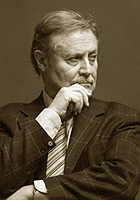 |
| Yuri Solomin |
The aesthetic platform of the School and high quality training for future actors are now being determined by the artistic directors of Russian courses and national studios. The most talented graduates, becoming the leading actors of the Maly Theatre and other Moscow theatres, eventually return to the School to teach.
The school has its own library, which founded in 1918. It contains over 30,000 printed books, including pre-revolutionary editions and a collection of rare books, and an electronic catalogue of 5,000 titles.
The marble plaque on the facade of the building is a silent witness of School’s history of two centuries that demonstrates that the great Mikhail Shchepkin lectured at this institution for 30 years, and whose name was then given to the school. The other one recalls the beginning of Maria Ermolova's creative path. Today one of School’s scholarships is named after Ermolova for the most gifted students in recognition of their outstanding achievements as well as one of the auditoriums where graduation plays are performed.
Professor Boris Lyubimov is the school’s rector and professor Alexander Shuiskiy is the pro-rector for academic and research work.
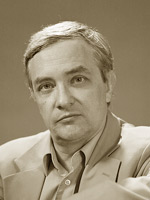 |
| Boris Lyubimov |
In 1980’s and 90’s the Maly Theatre and the School have experienced a real unity. Among other theatrical universities in Russia, The Mikhail Shchepkin Higher Theatre School, holds its place of honour, remaining a school of true life, high standards of speech and emotional intensity.
In 2009, the Higher Theatre School celebrated its 200th birthday. Over the last decade, many talented graduates of the School have joined Maly Theatre’s company, among them Olga Abramova, Georgi Vavilov, Polina Dolinskaya, Alexander Driven, Lyubov Eshchenko, Olga Zhevakina, Irina Zheryakova, Petr Zhikharev, Alexandra Ivanova, Timofey Karataev, Denis Kurochka, Irina Leonova, Dmitry Marin, Mikhail Martyanov, Philip Martsevich, Lydia Milyuzina, Olga Molochnaya, Daria Podgornaya, Ekaterina Porubel, Sergey Potapov, Grigory Skryapkin, Maxim Khrustalev.
The Mikhail Shchepkin Higher Theatre School (Institute) is currently one of the leading institutions of higher theatrical education in Russia, a real cradle of Russia’s realist school. The Maly Theatre and its School are the undeniable national treasures of Russia with their own established artistic traditions.
Natalia Korolkova
An essay from the book «School of the Maly Theatre. 190th anniversary The Mikhail Shchepkin Higher Theatre School (Institute)», Moscow, 2000.
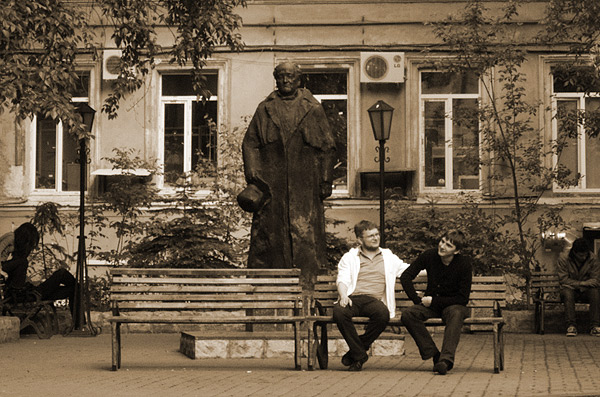 |
| Mikhail Shchepkin monument in the courtyard of the School (current photo) |























